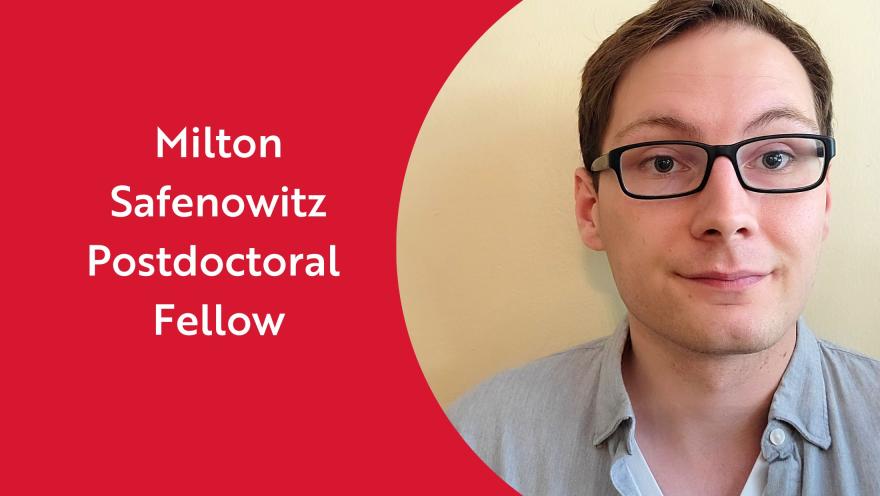To find new treatments and a cure for ALS, it’s vital to have a dedicated network of scientists working to advance our understanding of the disease and thinking creatively about solutions.
We are proud to support the development of bright, young researchers – and their innovative ideas – through our Milton Safenowitz Postdoctoral Fellowship Program. Established in memory of Milton Safenowitz by the Safenowitz family, this unique program encourages young scientists to enter and, importantly, remain in the ALS field. After completing this fellowship, more than 75% of awardees stay in ALS research. Many go on to establish their own laboratories and mentor more ALS researchers along the way.
During the 2022 funding cycle, five new Safenowitz fellows were selected from a highly competitive applicant pool, including Dr. Kevin Rhine, a postdoctoral scholar at the University California San Diego. We talked with him to learn more about his research, as well as his interests outside the lab.
What made you want to focus on ALS research?
I feel a personal connection with patients and families grappling with how ALS uproots their lives – my grandfather was diagnosed with Parkinson’s disease over 15 years ago, and I remember how his hand tremors and other symptoms worsened over the years. Like Parkinson’s disease, our treatment options for ALS are hamstrung by a lack of understanding of what causes the disease at the molecular level. Scientifically, ALS is a fascinating problem, but the human side of the disease – the patients and families hoping for answers and better treatments – is what drives me to continue my research.
What are the goals of your funded research project?
ALS primarily affects older adults. One of the biggest challenges in ALS research is dealing with the aging component of the disease. Science usually operates on the timeline of months to years, but ALS onset operates on the scale of decades. Therefore, the main goal of my research is to generate “aged” neurons from the skin cells of people living with ALS. I plan to investigate how aged neurons differ between healthy people and people living with ALS. In the lab, I can genetically manipulate the aged neurons to identify the molecular defects linked to ALS. These aged neurons can also be used to screen potential treatments much more quickly than mouse models.
How might your work impact the ALS community?
There are a bunch of cellular processes that are disrupted in ALS: protein aggregation, DNA damage, autophagy, nucleocytoplasmic transport and others. We are not really sure which of these problems cause ALS, especially in the context of aging. The results of my research should help the field focus on which problem is causative because I can directly investigate aged neurons derived from patient samples rather than using mouse models or non-aged cell cultures. We are fortunate to have a lot of federal and non-federal funding to study ALS, but it would be helpful to know where to focus our research efforts.
What role will this fellowship play in your research efforts?
The Safenowitz Fellowship will be pivotal in getting my research efforts started. My research relies on patient samples (skin biopsies), and the strong connection to the ALS community will allow me to collaborate with clinical researchers to obtain these samples. I am also excited to collaborate with other basic researchers to test their hypotheses in the aged neuron system I am developing.
What do you like most about working in the ALS research field?
I researched an ALS-linked protein (FUS or fused in sarcoma) for my Ph.D work. Over the past five years, it’s been clear to me that the researchers, federal government and non-profits like The ALS Association are all determined to do their best to find a cure for ALS. On the research side of the equation, a collaborative ethos permeates throughout the field. In other areas of research, it can be a bit competitive to get papers published, but I have never had that experience in the ALS research field. I think this is because of the strong support from non-profits like The ALS Association and because patients/families and the research community are strongly engaged with one another. The focus is finding a cure, not getting credit.
What gives you hope that there will one day be a world without ALS?
In science, we are always making progress, even if it is slow. My peers working on basic and clinical research are talented and determined to make progress in this field. The strong connection between the patient community and physicians will help accelerate our progress.
What do you like to do outside of the lab?
I try to maintain a healthy work-life balance so that I am at the top of my game when in lab. Outside of the lab, I enjoy hiking, playing golf and tennis, gardening, baking sweets and playing with my cat, Zelda. I also like to travel when I can!
Is there anything else you’d like to add?
I am deeply thankful for the support from The ALS Association through the Safenowitz Fellowship, and I am hopeful that my research will meaningfully contribute to both our understanding of ALS and the development of new treatments.
If you would like to receive monthly ALS research updates, SUBSCRIBE to our newsletter, Research Matters.
To continue to follow stories about people living with ALS in the community and learn more about the disease, subscribe to receive our weekly blogs in your inbox HERE or follow us at als.org/blog.


Comments
I would be happy to donate skin for your research. Simply let me know the process please.
Thank you Jane for offering to donate skin. You can reach out to the National ALS Biorepository at https://www.cdc.gov/als/ALSNationalBiorepository.html to see if you would meet the criteria.
Join the conversation. Please comment below.